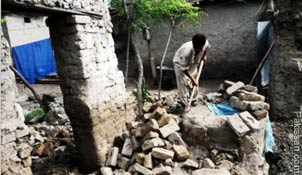|
 MUZAFFARGARH,
8 April 2011- Eight months after floods forced Saleemullah
Adeel and his family to abandon their home in Pakistan’s
southern Punjab city of Muzaffargarh, the road to recovery
has proved rough for this landless farmer. MUZAFFARGARH,
8 April 2011- Eight months after floods forced Saleemullah
Adeel and his family to abandon their home in Pakistan’s
southern Punjab city of Muzaffargarh, the road to recovery
has proved rough for this landless farmer.
The wheat he planted on 10 acres (four hectares) leased from
a large landowner at an annual fee of US$118 per acre (0.4
hectares) is doing well, and Saleemullah hopes for a good
crop because weather conditions so far have been good. Near
his house, which is now partially repaired, there are neat
rows of vegetables, and a few hens feed in the yard. But he
has little else to be happy about.
“I bought wheat seed and fertilizer after selling the
jewellery we had purchased for my elder daughter’s wedding,
which was scheduled for this month,” Saleemullah told IRIN.
“Now it has been postponed [yet] I have used up all my
savings and my two sons, who worked on fish farms, have lost
their jobs.”
The July-September 2010 floods destroyed hundreds of fish
farms in the Muzaffargarh area, according to media reports,
leaving many, like Saleemullah’s sons, out of work.
But Saleemullah’s problems do not end here. Since he did not
own the land he farmed, he was not awarded compensation by
the provincial government, which gave landowners seed and
fertilizer. “The landlord we lease from claimed he needed
[the seed and fertilizer] for his own lands,” he said.
Cotton crop destroyed
Other people, too, have suffered. “I have earned nothing for
months because the cotton crop was destroyed, and factories
which crush the cotton seed to extract oil did not employ us
this time as they usually do,” said Ahsan Akhtar, 30, whose
wife was not hired this year as a cotton-picker.
Across the country, people have continued to live with
losses incurred during the floods, even as they attempt to
recover, but this is proving tough. “My youngest child, aged
six months, has had diarrhoea for nearly a month,” said
Sanober Bibi, 25. “The health workers who used to visit
early on after the floods no longer come, and the medicine
given by the local midwife did him no good at all.” There is
no clinic in their village.
On 6 April Neva Khan, country director of the UK Charity
Oxfam, pointed fingers at the government, telling reporters
that a delay on the part of the government to provide a
“reconstruction strategy” had resulted in delays in urgent
rebuilding and recovery work. In some cases this had “barely
started even eight months after the disaster”, he said.
A government official refuted that claim. "The
rehabilitation phase was started some months ago," Ahmed
Kamal, spokesman for the National Disaster Management
Authority, told IRIN. A Sindh government official, who
preferred anonymity, said a "desperate lack of funds" was
holding up recovery in the province, but "progress was
slowly being made".
Lack of shelter, drinking water
Last year, the law was changed with many functions
previously conducted by the centre, devolved to provinces.
This has complicated reconstruction planning, aid workers
said. For example, in many flood-hit areas in the provinces
of Khyber Pakhtunkhwa, Sindh and Balochistan, people still
lack shelter.
According to a survey conducted for Oxfam by the Pakistani
NGO Free and Fair Election Network, 70 percent of
flood-affected people are also seeking jobs. “People want
jobs, not handouts,” Khan added.
On 31 March, the UN Office for the Coordination of
Humanitarian Affairs (OCHA) said the floods, which affected
more than 18 million people, had left behind a wave of
sickness and destruction that has still to recede, even as
the water dries up. An OCHA fact sheet said shelter and
clean drinking water were still required. Many people were
also still suffering from diseases.
In many flood-hit areas, pools of water in low-lying areas
have become rubbish dumps. “This adds to the spread of
disease, and dirty water sometimes contaminates clean
supplies used for drinking purposes,” Rafia Ali, a doctor,
said.
“The floods have vanished off TV screens; only limited
amounts of aid are reaching survivors - but the havoc caused
by one of the biggest natural disasters in the country’s
history continues, with no end yet in sight,” he added.
That view was shared by Ibrahim Mughul, chairman of
Pakistan’s Agriculture Council. "The agricultural losses
caused by the floods were devastating,” he told IRIN.
“Recovery will take a long time.”
Courtesy: IRIN
|
Pakissan.com;
|